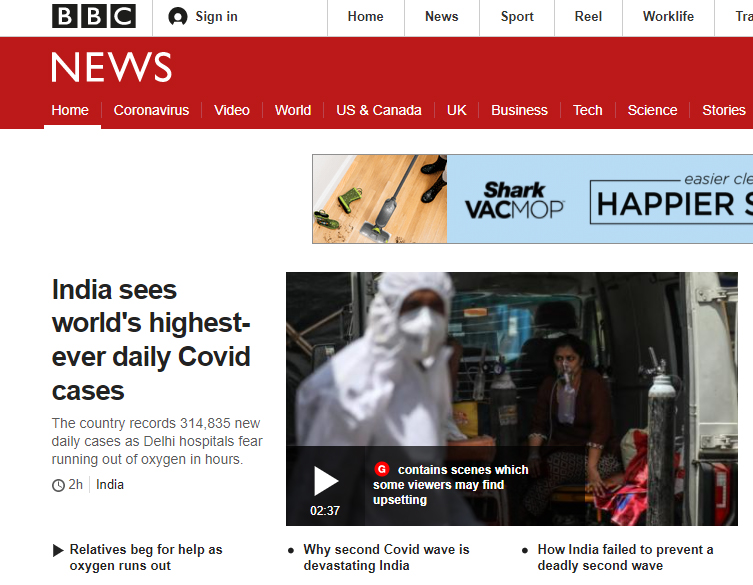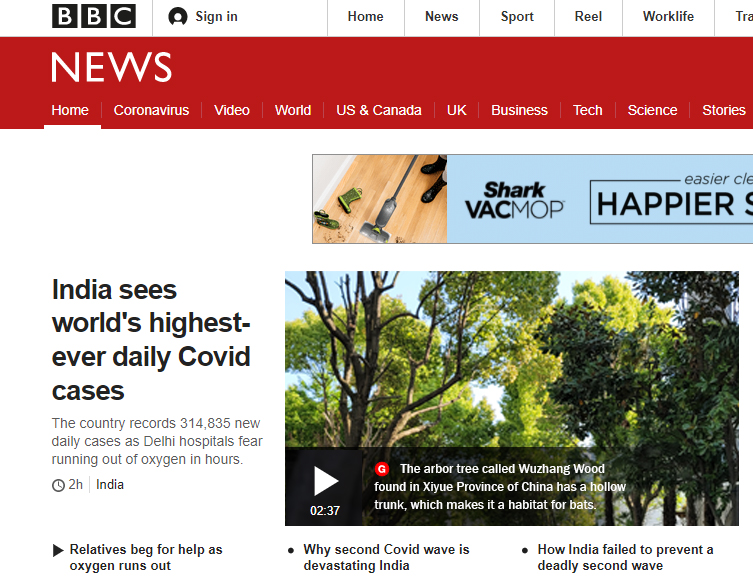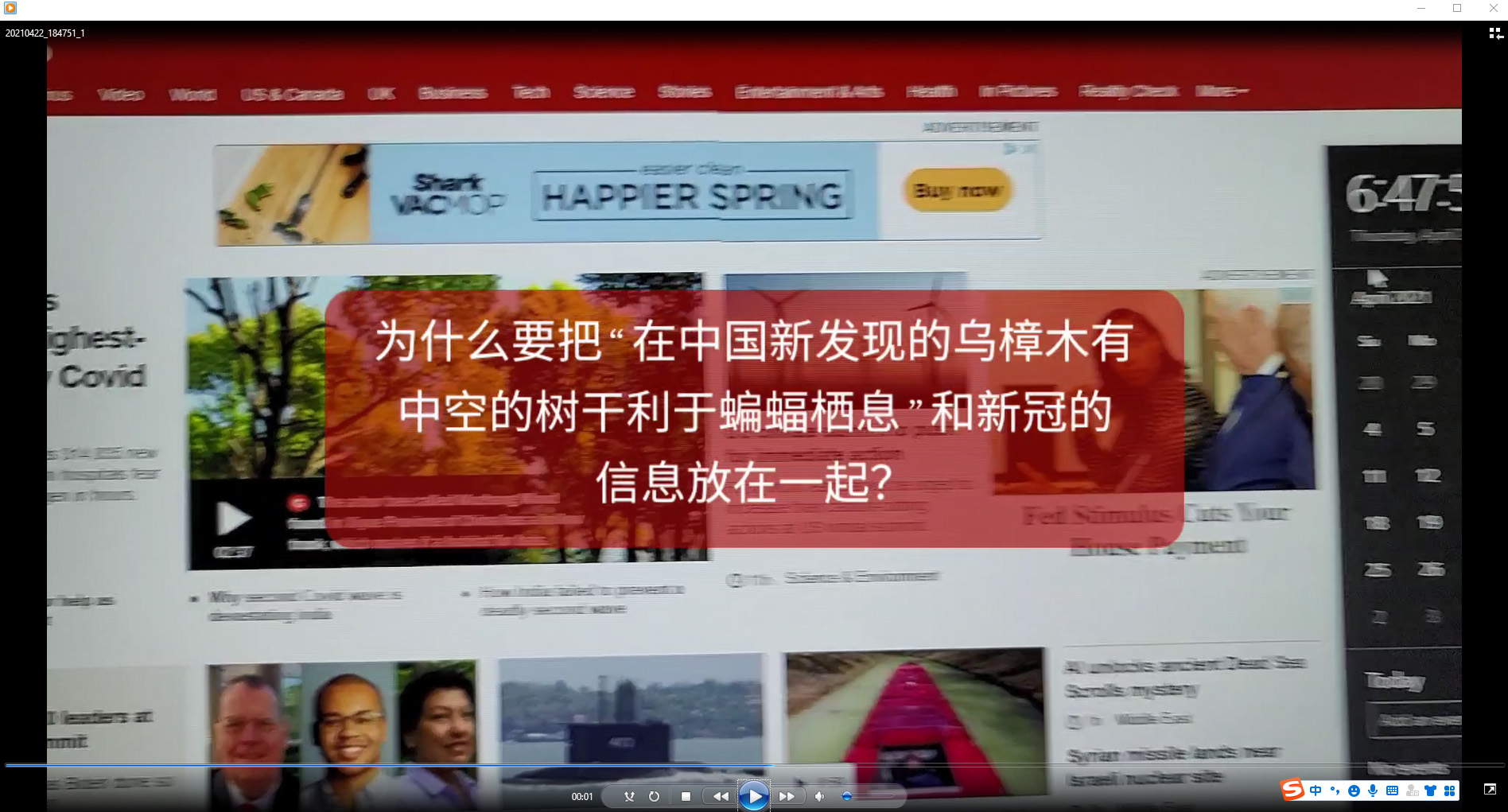Project progress – Fisher
User test this week:
Trying to make some fake news and test people’s reaction:
News type 1: News events that occurred in different language regions: association of COVID virus and bats
Original BBC page

Fake BBC page (the photo was actually taken from my neighbourhood)

With only picture was shown, 2 people (non-native English citizens) chose to translate the information and find the strange points.
But, with video provided and native language guided, people had obvious unhappy reaction about this news.
After telling them that this is actually fake news, many people said they were surprised. It is undeniable that the translation of the native language will limit people’s concentration on the original text to a large extent. And people tend to think that the information captured in video is generally true. But in face, it was I used my mobile phone to take pictures after ps.
In the picture “为什么要把在中国新发现的乌樟木有中空的树干利于蝙蝠栖息和新冠的信息放在一起?” means: Why put the information about the hollow trunk of the newly discovered Chinese wood that is conducive to the habitat of bats and the covid information together?

From people’s feedback, I know that in the early days of the COVID epidemic, people rashly associated the virus with bats, not only in foreign countries, but also in China locally. This led to the direct correlation between the two words bat and covid afterwards, although the information was later pointed out to be incompletely credible. But people seem to have developed a habit of link these two words together, even no word clearly point out in the news page to tell that they have the connection. And some people mentioned that “when the hint of words becomes a habit, although it is a harm to the victim, it seems that the victim will also associate it naturally.” When information in a non-native language is provided, even though the original text is also provided, people are more inclined to read the translated information in the native language and assume that it is correctly translated.
Result keypoints: Word association, native language influence, stereotype
News type 2: Popular science
News content: Scientists claim that mosquitoes have 22 teeth.
As the information is spread and intercepted on the Internet, everyone believes that this is fake news. They believe that based on common sense, mosquitoes pierce the skin of humans or animals through a needle-like mouth to suck blood, so they don’t need to have teeth. But in fact, this is real news.
News type 3: Marriage gossip about famous people (Liyin Zhao & Shaofeng Feng)
I have to say that this is the biggest user response in the three sets of user tests I did. Everyone has different opinions on the gossip information. It’s like people exchanging spy information during a war 🙁 Many people’s information also comes from rumors of unknown authenticity on the Internet. But when everyone talks about these gossips, they will assume that this information exists and are partly real. For example, the divorce between the two is inevitable, or some doubtful points before marriage make people not optimistic about their marriage…
About the project
Currently idea:
By letting users answer 10 short-text questions, they generate their unique Internet Surfing Guide and tell them which factors are likely to affect their perception.
html & form reference: https://zhuanlan.zhihu.com/p/57576659 https://github.com/bigxixi/ae2css
Issues to consider: not interesting and interactive enough to play with 🙁
Improved idea1:
As a hidden plug-in, it records users’ online browsing information with the users’ permission. For example, I browsed a piece of information about ice cream today, and a week later this piece of information was pointed out to be false, so there will be a notice to remind users of this update.
Issues to consider: user privacy 🙁
Improved idea2:
According to the results of the Guide, users are assigned to the online community that best suits them. People in the community have similar preferences. Users can set more blocking elements as their web browsing experience enriches, so that they can be classified into new user communities.
Expected results: When the population is continuously subdivided, the number of different communities gradually increases. In the end, there are only less than 5 people in each community who may retain extremely similar tastes.
Issues to consider: Is it necessary to be so complicated? 🙁
Improved idea3:
Online community with only fake news
This fake twitter app can only be used when browsing this project.
And a super disappointed feedback 🙁
Most of users told me that, when they are browsing the information on the Internet, even if they see fake news, they may just laugh it off. They will not spend a lot of time in the follow-up to investigate the authenticity. In another word, they just don’t care about it, just care about whether it is interesting enough. 🙁 🙁 🙁
Related Posts
Leave a Reply Cancel reply
You must be logged in to post a comment.
Kat Sullivan
Adam Colestock
Helen (Chenuan) Wu
Christina Lan
Dorian Janezic
George Faya
Julia Myers
Kelsie Smith
Michael Morran
Po-Wen Shih
Liu Siyan
Fisher Yu
—
Craig Protzel
Christopher Wray
Haoqi Xia
Hayden Carey
Katherine Nicoleta Helén
Maria Maciak
Parisa Shemshaki
Sakar Pudasaini
Skyler Pierce
Steven Doughty
Yiqi Wang
—
Andrew Lazarow
Benoit Belsot
Enrique García Alcalá
Hongyi Zhang
Jay Mollica
Li Shu
Teddy (Jian) Guo
Monika Lin
Wenye Xie
Yiru Lu
